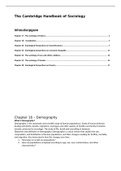The Cambridge Handbook of Sociology
Inhoudsopgave
Chapter 17 - The sociology of Culture................................................................................................................... 3
Chapter 18 – Socialization.................................................................................................................................... 5
Chapter 20 - Sociological Perspectives on Social Structure....................................................................................7
Chapter 23 - Sociological perspectives on economic inequality...........................................................................11
Chapter 24 - The sociology of race and ethnic relations.......................................................................................13
Chapter 25 - The sociology of Gender................................................................................................................. 15
Chapter 38 - Sociological Perspectives on Poverty............................................................................................... 17
Chapter 16 – Demography
What is Demography?
Demography (= the systematic and scientific study of human populations). Study of human behavior
dealing with births, deaths, migrations, marriages and other aspects of families and family formation
(closely connected to sociology). The study of life, death and everything in between.
Objectives and definition of demography; Demography is a social science that studies the size,
composition, and distribution of human populations, and their changes resulting for fertility, mortality,
and migration. Also interested in how this changes over time.
1. How large (or small) are populations?
2. How are populations composed according to age, sex, race, marital status, and other
characteristics?
, 3. How are populations distributed in physical space?
The Demographic Equation
The demographic processes; components of
demographic change;
Fertility
Migration
Mortality
Population change is caused by a limited number of
events. Entering (being born, moving in) and leaving
(dying, moving out).
B > D = positive natural increase
B < D = negative natural increase/ natural decrease (can be because of proportionally elderly population)
I > E = positive net international migration (often in developed countries)
I < E = negative net international migration (often in developing countries ‘sending countries’)
understanding how the many factors cause changes in demographic behavior and that the
consequences of this behavior are all interrelated.
Age and Sex
Age and sex are the most import characteristics of a population/ population structure. They are “the
demographic characteristics”. They are closely tied with the three demographic processes.
Fertility
- Actual production of children (sex)
- Fecundity; ability to produce children (age and sex)
Mortality
- Death rates (age and sex)
- Cause-specific mortality (age and sex)
Migration
- long distanced vs. short-distanced migration (sex)
- Mostly young adults (age)
Other characteristics/ compositional variables: marital status (fertility), race (socio-economic status),
education (fertility and mortality)
Both the cause and effect of population change. Demographic changes can also affect the variables.
Age composition: An Example
Baby boom, a bulge in the population, an age group that is considerable larger than the groups before or
after it. This caused problems such as a shortage of teachers and overcrowded schools, not enough jobs,
scarce housing, etc. The generation following the baby boomers had a more favored position during their
lives (but they do need to finance the retirements of the baby boomers).
Our generational location has a big influence on our lives and our life chances. As noted earlier, however,
age is just one compositional variable that impacts our lives and the society in which we live.
Sex composition: An example
sex ratio at birth (SRBs), 105 boys for every 100 girls is evolutionary correct because males have higher
death rates than females at every age. The SRBs in China is around 120, that means that there are much
more boys than girls being born and that there will be too many bachelors. Men that do not marry are
more prone to crime than married men. There will also be a chance for an HIV/AIDS epidemic, through
sex markets.
, These are the kinds of societal impacts that are likely to occur when the sex ratio becomes significantly
unbalanced.
Population distribution
Populations are not equally distributed across the planet. Population distribution reflects levels of
fertility, mortality, and migration. Newer cities are often increasing because of in-migration. Humans are
peripatetic.
The data of demography
Most of the time, the data that demographers use has already been gathered for them.
- US Census Bureau – national and international data
- US National Center for Health Statistics (NCHS) – fertility, morbidity, causes of death, mortality.
- US Citizenship and Immigration Services (USCIS) – immigration
- US States – own demographic data centers
- United Nations (UN) Population Division – data for every country in the world
- US Central Intelligence Agency – data for every country in the world
Conclusion
Definition demography; the scientific study of the size, composition, and distribution of human
populations, and their changes resulting from fertility, mortality, and migration.
Demographers study important aspects of our lives; births, deaths, migrations, and marriages.
Demographic dynamics are influenced and influence compositional aspects; like age and sex.
Demography is crucial for a full understanding of most forms of human behavior. It is also invaluable for
the larger society (for example; cluster marketing and environmental planners).
Chapter 17 - The sociology of Culture
Mean-makings
⁃ How do mean-makings happen?
⁃ Why do meanings vary?
⁃ How do meanings influence human actions?
⁃ In which ways is meaning-making important in social cohesion, domination, and resistance?
The diversity of opinions on meaning-making reflects the width of culture itself.
Two fundamental meanings of culture:
1. Social scientists have used the term culture to describe those phenomena associated with the
more artistic and expressive domains of social life. Studies how cultural activity creates, cultivated, and
conveys meanings by reflecting and commenting on shared living experience.
2. Culture is a broader construct, something that embodies what has sometimes been called a
‘whole way of life’, thereby describing how a community or group of people share common habits,
beliefs, tastes, norms, values, practices or life-styles.
—> 2 is more expansive, embraces the sociological study of the expressive and meaningful components
of social life and includes all the different aspects that constitute a society.
All social experiences are drenched in cultural meanings. Cultural life can establish social life and vice
versa.
The two roots of cultural sociology
Five foundational words in the 18th century that came into common usage:
Industry, democracy, class, art and culture.
—> transformation in the organization of society & the experience and responds to them by the people.






